Are you ready to feast your eyes on a dazzling array of orange animals that are as stunning as they are unique? Look no further! In this blog post, we’ve rounded up 12 gorgeous orange creatures that will leave you awe-struck. From the majestic tiger to the vibrant monarch butterfly, these animals are sure to brighten up your day. So sit back, relax, and prepare to be amazed by the beauty of nature’s vibrant palette. Get ready for a visual treat as we take you on a journey through the animal kingdom’s most vibrant shades of orange. Let’s dive right in and explore the world of these incredible creatures with pictures that will leave you speechless!
1. The Majestic Tiger: A Vibrant Vision in Orange
In the vast and varied tapestry of the animal kingdom, one creature stands out in the crowd for its stunning orange coat accented by bold black stripes – the tiger. As the first entrant in our list of delightful orange animals, the tiger is undeniably an iconic symbol of beauty, power, and majesty across the globe.
These magnificent beasts are native to various regions of Asia, with six different subspecies still gracing our world today. Each subspecies, from the Siberian to the Sumatran, carries its unique charm, yet all share the same striking orange coat, making them an unforgettable sight in their natural habitats.
Far from being merely decorative, the tiger’s vibrant coat serves a critical function. Acting as a natural camouflage amid lush vegetation, it aids these apex predators in their relentless pursuit of prey. Buffaloes, deer, and wild boars are some of the larger meals on a tiger’s menu, showcasing their prowess as skilled hunters.
Did you know? The coat of a tiger not only helps it blend in with its environment but also communicates its power and dominance to other animals.
However, the tiger’s tale is not all about strength and survival. Tragically, each subspecies of this magnificent creature is currently categorised as either endangered or critically endangered. The wild tiger population is estimated to be a mere 4,000, a sad testament to the impact of human intervention on these splendid creatures.
| Tiger Fact Summary |
|---|
| Scientific Name: Panthera tigris |
| Type of Animal: Mammal |
| Native to: Various regions of Asia |
| Number of Subspecies: 6 |
| Prey: Large animals like buffaloes, deer, and wild boars |
| Conservation Status: All subspecies are either endangered or critically endangered |
| Estimated Number in the Wild: Around 4,000 |
As we continue our journey through the intriguing world of orange animals, let’s remember the tiger – a testament to nature’s artistry and an urgent call for conservation.
2. The Vibrant Monarch Butterfly
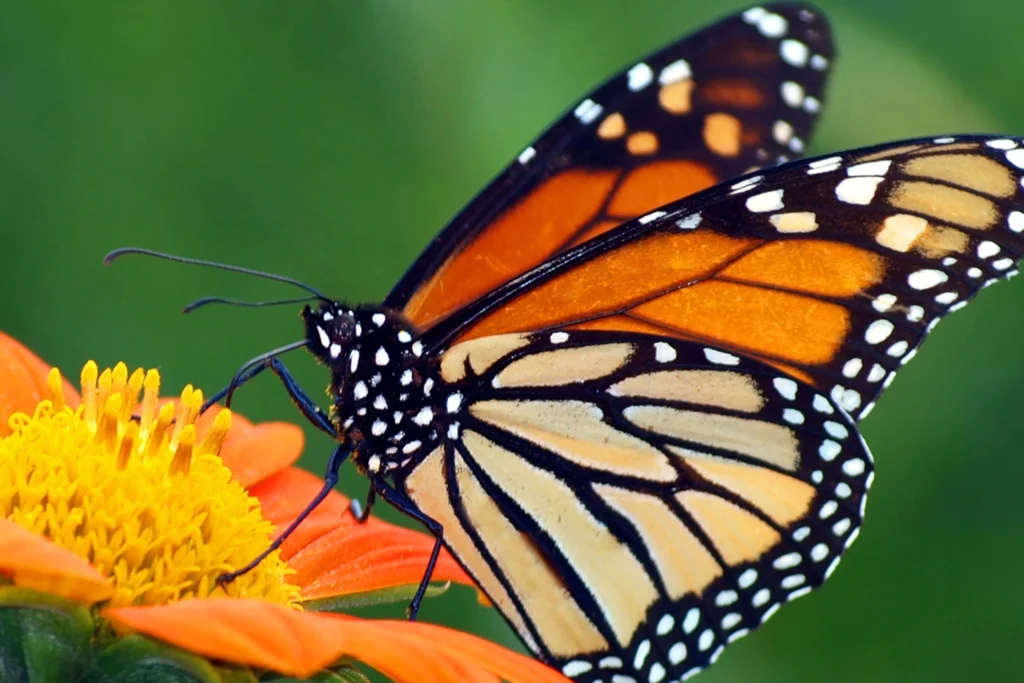
monarch butterfly
Imagine an insect so vibrant and full of life, it seems to have been painted by Mother Nature herself. This is none other than the Monarch Butterfly, scientifically known as Danaus plexippus. Its orange and black wings are not only a spectacle to behold but also serve as a warning to predators, signalling their unpalatable taste.
These brilliant creatures are not confined to a single location. They grace the lands of the Americas, some regions of Oceania, and even parts of Europe with their elegance. However, it’s the North American population that has become a symbol of resilience and endurance.
Every year, these tiny yet tenacious beings undertake a phenomenal journey, traveling up to 3,000 miles from their breeding grounds in Canada to their wintering haven in Mexico. This migration is not just a testament to their navigational prowess, but also an awe-inspiring natural phenomenon that leaves spectators spellbound.
Read more: What are the Different Types of Raccoons? Unveiling the Fascinating World of Raccoon Species
Not merely fluttering ornaments in the sky, Monarch butterflies play a pivotal role in our ecosystems as pollinators. They aid in the reproduction of a myriad of plants, making their existence vital.
“Their journey, their role in our ecosystem, and their striking beauty make Monarch butterflies truly one of nature’s most fascinating creatures.”
Unfortunately, this vibrant species is facing escalating threats that could shatter their existence. The loss of habitat, primarily due to deforestation and urban development, is a pressing concern. Additionally, climate change poses a significant challenge, as it can alter their migratory patterns and breeding grounds.
Check out: Unraveling the Enigma: 6 Possible Wolf Colors – What Do They Signify and How Do They Come About?
These threats remind us of the delicate balance of our ecosystems and the importance of preserving the natural world. The tale of the Monarch Butterfly invites us to reflect on our role in this shared planet, and how our actions can shape the fate of even the smallest creatures.
3. The Expressive Orangutan: A Silent Lament of the Rainforest
When we journey to the lush rainforests of Sumatra and Borneo in Southeast Asia, our eyes are drawn to a rather extraordinary sight – the expressive orangutan. These great apes, represented by three unique species, command attention with their strikingly human-like expressions and their vibrant fur, a stunning blend of orange and brown that mirrors the warm tones of their forest home.
“Orangutans, with their contemplative eyes and gentle demeanor, are the silent poets of the rainforest.”
Orangutans, true masters of their arboreal world, have adapted to a life high in the trees. Night after night, they construct elaborate sleeping nests, a testament to their remarkable intelligence and resourcefulness. As the sun rises, they embark on a daily quest, foraging diligently for their primary sustenance – fruits.
Despite their strength and size, orangutans are often described as solitary creatures. They prefer a quiet existence, with their social interactions mostly limited to mother-offspring bonds. Females, showcasing their nurturing side, devote significant time and energy to caring for their young, teaching them the vital skills needed for survival in the dense jungle.
Read more: Which 12 Yellow Animals Will Leave You in Awe? (With Stunning Pictures)
Yet, these incredible creatures, who have made the rainforest their sanctuary, are now on the brink of extinction. The relentless expansion of oil palm plantations has resulted in rampant deforestation, decimating the orangutan’s habitat and pushing them towards a perilous future. Their current status as critically endangered is a stark reminder of the profound impact of human activities on the planet’s biodiversity.
As we move on to explore more orange animals, let’s carry with us the image of the expressive orangutan, a symbol of the rainforest’s beauty and fragility, and a poignant reminder of our responsibility to protect it.
4. The Adaptable Red Fox: The Brilliance of Orange in the Animal Kingdom

red fox
Imagine a creature, draped in a vibrant orange coat, its agile form spotted against the contrasting greens and whites of North America, Eurasia, and North Africa. This is none other than the magnificent Red Fox, the largest of all foxes and a testament to the brilliant orange hues found within the animal kingdom.
These creatures are not just known for their striking coloration, but also for their remarkable adaptability. Red foxes thrive in a myriad of environments, from the icy tundra to arid deserts, showcasing their resilience and versatility. They are opportunistic predators, revealing an intelligent and resourceful nature that sets them apart in the wild.
“In the grand canvas of nature, the Red Fox paints a vibrant orange, a testament to adaptability and survival.”
Interestingly, the diet of these foxes extends beyond the realm of traditional carnivorous predation. In addition to hunting small rodents, birds, and even insects, they are known to supplement their diet with berries and fruits, suggesting a level of dietary flexibility that contributes to their wide distribution and survival in different habitats.
| Features of Red Fox | |
|---|---|
| Species | Vulpes vulpes |
| Color | Orange |
| Habitat | North America, Eurasia, North Africa |
| Diet | Small rodents, birds, insects, berries, fruits |
The Red Fox, with its fiery fur and cunning demeanor, serves as a perfect example of the beauty and adaptability of orange animals in the wild. As we continue to explore the world of orange-hued creatures, their stories serve as reminders of the importance of biodiversity and the need to protect these animals and their habitats from various threats.
5. The Agile Red Squirrel: A Vibrant Forest Acrobat
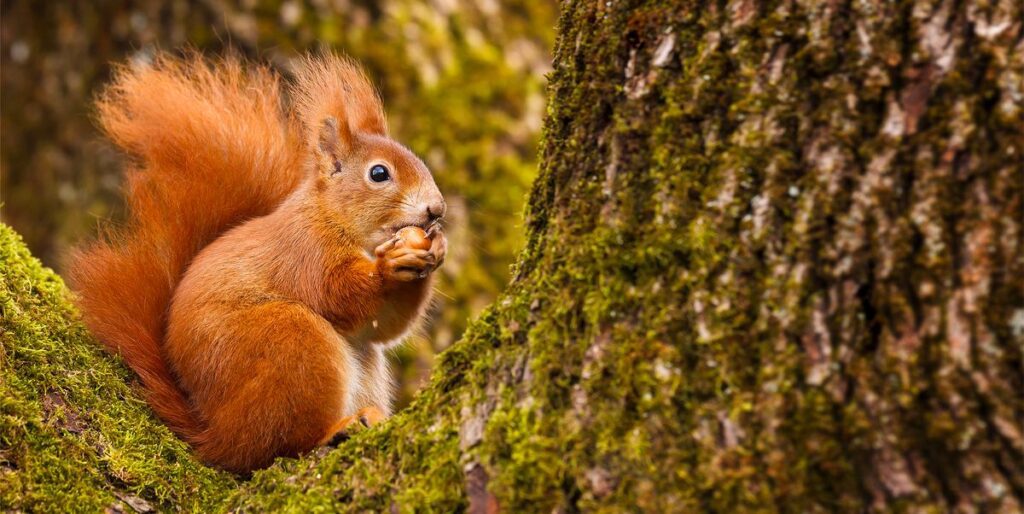
red squirrel
Embarking on a journey from the lush forests of Eurasia, let’s turn our attention to another orange marvel, the Red Squirrel (Sciurus vulgaris). With a distinctive red fur coat that glows like fiery embers and a bushy tail that sways like a feathery plume, they are a quintessential sight in the woodlands, gardens, and parks of their native regions.
Red squirrels are not just another pretty face in the animal kingdom, they are energetic acrobats, leaping from tree to tree with an agility that would make a trapeze artist green with envy. As they dart up and down trunks and navigate the high treetops, they display an unparalleled nimbleness and grace.
Read more: How Fast Can Lions Run? Unveiling the Secrets Behind the Lightning Speed of These Majestic Beasts
Their diet comprises mostly of seeds and nuts, with a particular fondness for hazelnuts. This eating pattern makes them indispensable for the forest ecosystem. Seed dispersal is a crucial ecological function, and these squirrels, with their habit of storing food for the winter, inadvertently scatter seeds across their habitat. It’s a beautiful example of nature’s balance: while feeding themselves, these creatures help in the propagation of the very trees that provide them with food and shelter.
Despite their social appearance, Red Squirrels are solitary animals for most of the year. Their interactions are limited to the mating season or during harsh winters. In these cold months, a few may huddle together in a shared nest, a practical solution to surviving the plummeting temperatures. This occasional communal nesting provides a rare glimpse into a more social side of these generally solo creatures.
These agile, orange-furred mammals, with their ecological significance and endearing behaviors, are indeed captivating members of the animal kingdom. As we continue our exploration of orange animals, let’s remember the role each species plays in the intricate tapestry of life on our planet.
6. The Endangered Golden Lion Tamarin: A Shimmering Beacon of Hope

golden lion tamarin
Emerging from the shadows of the Brazilian jungle, the Golden Lion Tamarin dazzles with its vibrant, fiery fur. This small, yet remarkable primate is an endangered species, confined to the coastal lowland forests in a minuscule region in southeast Brazil. Its radiant orange coat, which bears a striking resemblance to the majestic mane of a lion, has earned it its distinctive name.
“The Golden Lion Tamarin, known scientifically as Leontopithecus rosalia, is a testament to the beauty and diversity of orange animals. Its vibrant fur, like a sunbeam cutting through the dense foliage, is instantly captivating.”
Unlike the solitary red squirrel we previously discussed, the golden lion tamarin is a social creature. Societies of these tamarins usually consist of up to 8 members, typically a mating pair and their offspring. Their days are filled with the ceaseless search for food, with their diet primarily consisting of fruits and insects.
Their social nature extends to their foraging habits, where they work in unison to seek out sustenance. Just as the red fox adapts its diet to its surroundings, the golden lion tamarin thrives on a versatile diet, a testament to its resourcefulness in the face of limited resources.
Despite their resilience, golden lion tamarins face the looming threat of extinction. Just as with the orangutan, the destruction of their natural habitat is pushing them towards the brink. Yet, they stand as a symbol of hope, with conservation efforts showing promising results in securing their survival.
Indeed, the golden lion tamarin’s shimmering coat serves as a beacon of hope, a call to protect and preserve the vibrant palette of orange animals gracing our planet.
7. The Vivid Spectacle of the Guianan Cock-of-the-rock
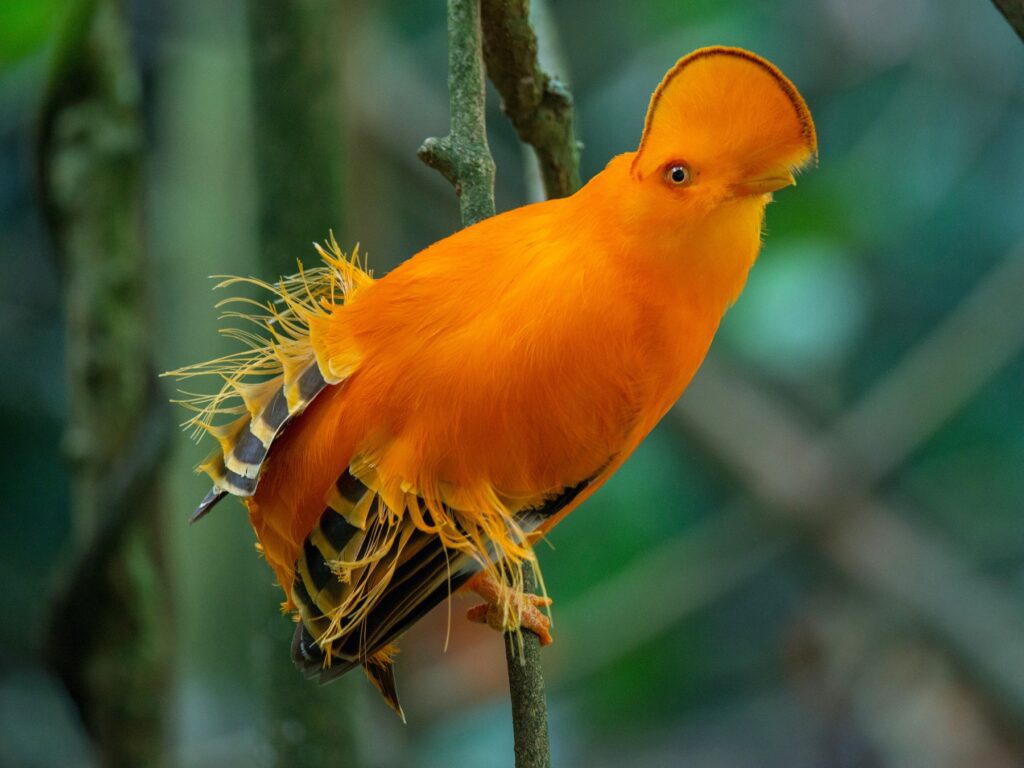
guianan cock-of-the-rock
Our journey through the realm of orange-furred animals now takes us to the lush, vibrant forests of the northern Amazon basin in South America. Here, amidst the chirping of insects and the rustling leaves, a flash of brilliant orange catches your eye. It’s none other than the Guianan Cock-of-the-rock, a bird whose striking plumage is as captivating as the tales of its behavior.
Scientifically known as Rupicola rupicola, this bird is a delightful spectacle of nature’s paintbrush. Its habitat spans across French Guiana, Suriname, Guyana, southern Venezuela, and northern Brazil. Yet, amidst the rich biodiversity of these regions, the Guianan Cock-of-the-rock stands out, thanks to its vivid orange hue that is sure to leave a lasting impression.
Yet, the allure of this bird is not limited to its color alone. The males of the species boast a distinctive crest adorning their head, a feature as functional as it is visually striking. This crest, coupled with their brilliant plumage, plays a pivotal role in their courtship rituals, making the Guianan Cock-of-the-rock a fascinating study in avian reproduction behavior.
Interestingly, the females of the species are more subdued in their appearance, featuring a greyish color palette and a less prominent crest. This contrast between the sexes only adds to the intrigue surrounding these birds, further cementing their place in our list of gorgeous orange animals.
Check out: Unveiling the Enigma: What Makes the Jaglion the Rare and Mystical Hybrid of a Lion and a Jaguar?
Whether it’s their striking appearance or their captivating behavior, the Guianan Cock-of-the-rock certainly warrants attention. As we continue our exploration of orange animals, remember the vivid spectacle of this bird, a testament to nature’s endless creativity and diversity.
8. The Popular Goldfish: A Splash of Orange in Domestic Aquaria
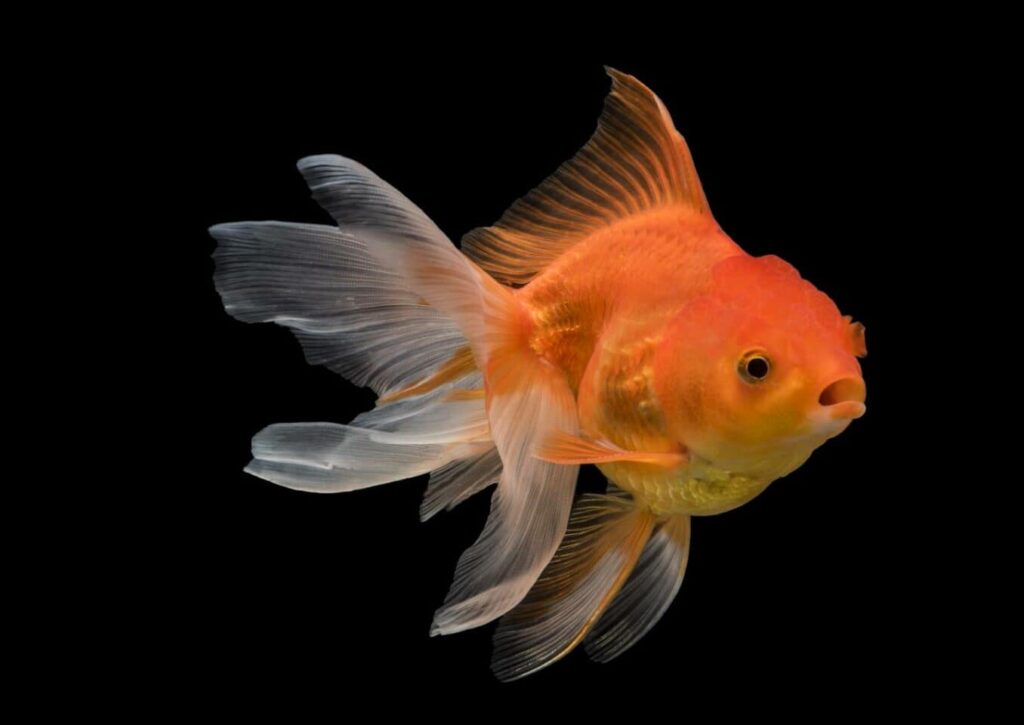
goldfish
When it comes to aquariums that dot the corners of homes worldwide, the star performer often stealing the show is none other than the goldfish. A testament to the allure of orange animals, goldfish are the most commonly kept aquarium fish across the globe.
Belonging to the Cyprinidae family, which also includes species like carp, goldfish have their roots in China. Here, around a millennium ago, the art of selective breeding transformed the originally greyish fish into a vibrant spectacle of red, orange, and gold. These multicolored variants were initially curated to adorn the garden ponds of the imperial families, adding a dash of color and life to their serene waters.
Goldfish are not just about aesthetics; their colors are a fascinating palette that ranges from bright orange to pristine white, with a multitude of patterns unfolding in between. It’s a captivating display of nature’s creativity, making each goldfish a unique work of art.
But their charm doesn’t stop at their radiant coloration. Goldfish also possess an intriguing life cycle. In their natural habitat, which includes ponds and slow-moving streams, goldfish lay their eggs on aquatic plants – a delicate process that further underscores their connection to the vibrant life pulse of their environment.
From the wild waters of China to the cozy corners of homes around the world, goldfish have become synonymous with domestic aquaria. Their lively personalities and unique aesthetic appeal make them a beloved addition to any household. So, next time you see a goldfish, remember: they’re not just swimming in water, but also in a rich history that spans continents and centuries.
9. The Symbiotic Clownfish: A Vivid Splash of Orange Underwater
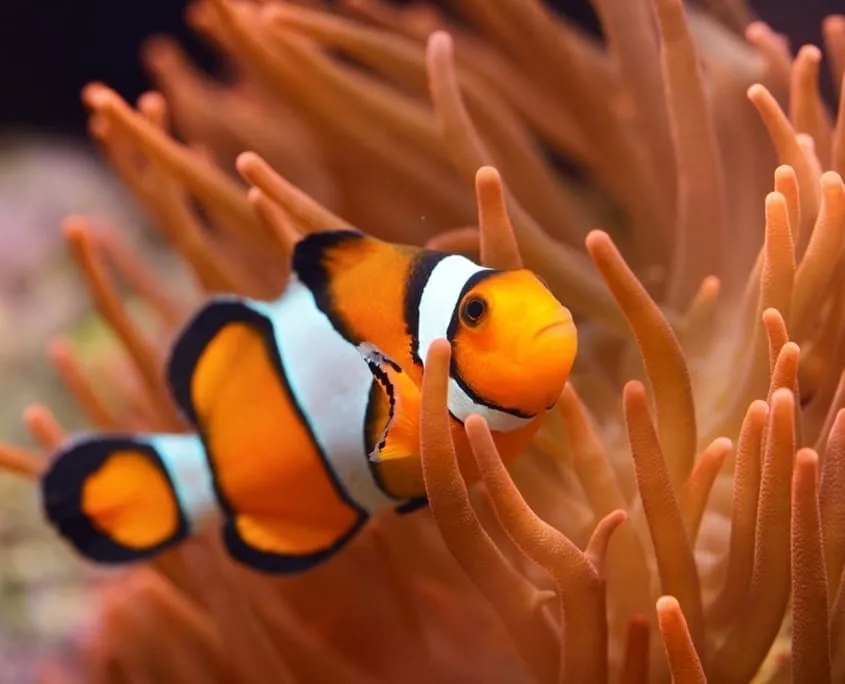
clownfish
As we journey from the vibrant terrestrial world to the mesmerizing depths of the ocean, we encounter a delightful creature that stands out with its striking orange hue against the blue expanse – the clownfish. Sometimes referred to as anemonefish, this tropical marvel hails from the warm waters of the Indian and Pacific Oceans. Its existence is a captivating tale of survival, symbiosis, and splendor, all wrapped in an orange-striped package.
Belonging to the subfamily Amphiprioninae, these fish are not just beautiful, but also boast of a fascinating relationship with sea anemones. This symbiotic interaction forms the backbone of their survival strategy, much like the Guianan Cock-of-the-rock’s reliance on its vibrant plumage for courtship rituals or the Goldfish’s need for aquatic plants during their reproduction process.
Clownfish and sea anemones: a perfect example of nature’s give-and-take
While the anemone might seem like a dangerous dwelling with its venomous tentacles, for the clownfish, it’s a sanctuary. The anemone provides a safe haven, protecting the clownfish from would-be predators, and even sharing its leftovers with the fish. In return, the clownfish guards the anemone against its enemies and keeps it clean from parasites, a unique partnership that’s as fascinating as it is functional.
Read more: What Eats Vultures? Discover the Top 8 Predators that Prey on Vultures
However, it’s not just their symbiotic relationship that makes clownfish remarkable. With their bright orange bodies contrasted by white bands, clownfish are undoubtedly one of the ocean’s most recognizable residents. Their vibrant appearance, combined with their intriguing lifestyle, has made them a popular choice amongst aquarium enthusiasts worldwide.
Unfortunately, the popularity of these orange wonders has a darker side. A significant 75% of clownfish in the pet trade are wild-caught, a disturbing statistic that raises concerns about their sustainability and the impact on their native habitats.
With every ripple they make in their colorful underwater world, clownfish remind us of the importance of coexistence, the beauty of diversity, and the delicate balance that nature maintains. As we continue our exploration of orange animals, the clownfish serves as a vibrant testament to the wonders that lie beneath the ocean surface.
10. The Mesmerizing Corn Snake
As we voyage further into the vibrant world of orange animals, our journey brings us to the Southeastern United States, home to a reptilian marvel – the Corn Snake. With its scientific name, Pantherophis guttatus, the Corn Snake paints a mesmerizing picture with its array of vibrant hues, reminiscent of the orange and yellow kernels on an ear of corn, hence its name.
Corn Snakes, unlike their venomous counterparts, pose no threat to humans. Their docility and non-venomous nature have catapulted them to popularity in the world of herpetology. Just like the goldfish and clownfish, Corn Snakes have found their place as beloved pets, their calm demeanor making them an excellent choice for reptile enthusiasts.
These fascinating creatures are not only known for their captivating colors and tame behavior but also for their hunting skills. Despite being non-venomous, Corn Snakes are effective predators, adept in the art of constriction. They weave their bodies around their prey, primarily small rodents, frogs, and other small reptiles, exerting pressure until the prey is subdued.
A master of adaptability, the Corn Snake thrives in diverse habitats. From open fields to forest fringes, even venturing into abandoned buildings, these snakes know how to make a home. Their proficiency in tree climbing further adds to their survival skill set, their slithering forms often found nestled amongst tree branches.
Read also: Deer Hooves Unveiled: The Ultimate Guide to Understanding Deer Feet
As we delve deeper into the captivating world of orange animals, the Corn Snake serves as a testament to nature’s variety and adaptability. Much like the symbiotic relationship between the clownfish and the anemone, these snakes too, play an integral role in their ecosystem, maintaining the balance by keeping rodent populations in check.
But remember, while their vibrant colors and calm nature make them desirable pets, it’s essential to respect their wild origins. As we move on to explore more of these captivating orange creatures, let’s remember the Corn Snake – a symbol of beauty, adaptability, and coexistence.
11. The Spotted European Fallow Deer: A Majestic Mammal of the Grasslands
Leaving the vibrant world of the clownfish and the mesmerizing aura of the corn snake behind, we journey next to the open grasslands near forests, the home of a captivating mammal known for its distinctive coat. This is the realm of the European fallow deer, a creature native to the breathtaking landscapes of Turkey.
The European fallow deer’s coat is a sight to behold; it’s as if a painter delicately brushed hues of brownish-orange onto their bodies. But the true magic lies in the pattern of white spots that dapple their fur, creating a stunning contrast that makes these deer stand out in their verdant homes.
“These deer live in open grasslands near forests and graze in large groups of more than 100 individuals.”
Size-wise, these deer are quite impressive. An adult fallow deer can grow up to 1.5 meters long and weigh as much as 100 kg. Their size, coupled with their striking coat, makes them one of the most majestic orange animals you’ll ever encounter.
In addition to their physical attributes, fallow deer are also known for their social behavior. They are not solitary creatures but prefer to live and graze in large groups, often consisting of more than 100 individuals. This herd mentality not only provides safety in numbers but also adds to their spectacle when spotted in the wild.
Despite being native to Turkey, these deer have found homes in different parts of the world, including Europe, Australia, South Africa, and the United States. Their adaptability to diverse environments echoes the themes we’ve seen with our previous orange animals and serves as a testament to the resilience and versatility of nature’s creatures. As we move forward in our exploration, let’s keep this spirit of adaptability in mind, for it’s a trait shared by many of the world’s most fascinating species, orange and otherwise.
12. The Sociable Impala: A Vital Player in the African Savanna
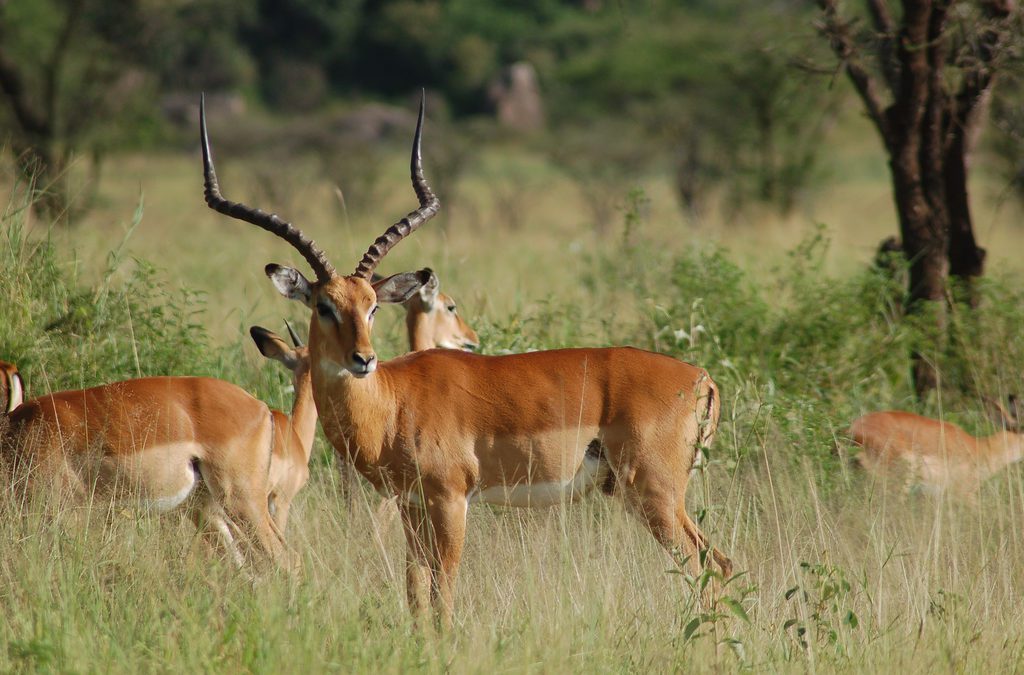
impala
Stepping away from the grasslands of Europe, we venture now to the diverse landscapes of eastern and southern Africa, the home of our next spectacular orange creature – the Impala. A beacon of sociability and adaptability, the Impala is an integral part of the savanna ecosystem, much like our previously discussed Corn Snake and European Fallow Deer.
Belonging to the genus Aepyceros melampus, the Impala is a medium-sized antelope that boasts a beautiful brownish-orange coat. This coat, shimmering under the African sun, adds a hue of warmth to the vast savannas. It’s a sight that leaves a lasting impression on all who see it.
The Impala has a few distinctive physical features. One of these is the male’s majestic horns, which can grow up to an impressive 90 cm, or 3 feet. Resembling a lyre in shape, these sweeping horns are not just a sight to behold, but also a testament to the Impala’s perseverance in the face of survival.
Scientific name: Aepyceros melampus
Type of animal: Mammal
Where found: Eastern and Southern Africa
Impalas are renowned not just for their striking appearance, but also for their highly social nature. They thrive in large herds, sometimes comprising more than 100 individuals, embodying the true spirit of community living. This strong social structure plays a pivotal role in their survival strategy, mirroring the social behavior of the European Fallow Deer we explored earlier.
These herds of Impalas, grazing peacefully under the African sky, form a quintessential part of the savanna landscape. Beyond the aesthetic, they serve a crucial purpose in the ecosystem. The Impala, with its widespread distribution from Kenya to South Africa and Namibia, is a key species in the African savanna ecosystem, just like the Corn Snake in its diverse habitats.
Interestingly, there are two subspecies of Impala: the common Impala and the black-faced Impala. The latter, with its smaller geographical range, is an exclusive resident of the region between northern Namibia and southern Angola.
In the grand tapestry of nature, every creature has a role to play. As we continue our journey of discovery, let’s not forget the vibrant Impala, its sociability, its adaptability, and its significant contribution to the African savanna.
The tiger is one of the most iconic animals in the world.
Tigers have an orange coat with black stripes.
Tigers use their coat as camouflage among vegetation.
Tigers hunt a variety of large prey such as buffaloes, deer, or wild boars.
Yes, all subspecies of tigers are either endangered or critically endangered.
It is estimated that there are around 4,000 tigers in the wild.
The scientific name of the Monarch Butterfly is Danaus plexippus.
The Monarch Butterfly is an insect.
The North American population of Monarch Butterflies migrates up to 3,000 miles between breeding grounds in Canada and wintering destination in Mexico.
Monarch butterflies are important pollinators.
Monarch butterflies are facing threats such as loss of habitat and climate change.
Orangutans are three different species of great apes.
Orangutans have orange, brownish fur.
No, orangutans are highly intelligent and solitary animals.
Orangutans spend a lot of time foraging for food, mostly fruits.
Deforestation for oil palm plantations is a major threat to the survival of orangutans.
The Golden Lion Tamarin can only be found in coastal lowland forests in a tiny region in the southeast of Brazil.
The Golden Lion Tamarin has dense, orange fur resembling the mane of a lion.
Yes, Golden Lion Tamarins are social animals and live in groups.
Golden Lion Tamarins spend most of their day foraging for food, mostly fruits and insects.
The Guianan Cock-of-the-rock is found in the northern part of the Amazon basin in South America.
The reproductive behavior of the Guianan Cock-of-the-rock is elaborate. Males gather in a specific spot in the forest called a lek. The female is perched in the lek and can observe the males’ performances. The female chooses the male she likes best.
The goldfish is the most commonly kept aquarium fish in the world.
The goldfish is native to China.
The Chinese started selecting red, orange, and golden mutations of the originally greyish fish around 1,000 years ago.
The scientific name of the Clownfish is subfamily Amphiprioninae.
A Clownfish is a fish.
Clownfish have a symbiotic relationship with sea anemones. The anemone provides shelter and food for the clownfish, while the clownfish provide protection to the anemone.
Yes, Corn Snakes can climb trees.
No, Corn Snakes are non-venomous and harmless to humans.
Corn Snakes kill small prey by constriction.
The European Fallow Deer has a brownish-orange coat with white spots.
The European Fallow Deer is native to Turkey and has been introduced to Europe and other parts of the world.
A European Fallow Deer can grow up to 1.5 meters long and weigh up to 100 kg.
The Impala has a brownish-orange coat.
An Impala can weigh up to 75 kg / 165 pounds.
Yes, Impalas are highly social animals that live in herds.
There are two subspecies of Impala: the common Impala and the black-faced Impala.

